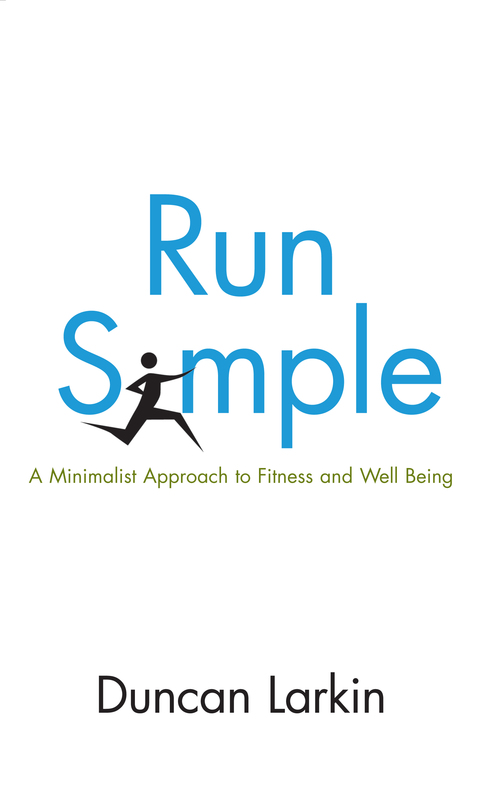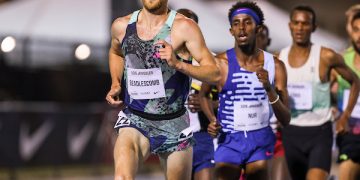
This is the front cover of the book, Run Simple, A Minimalist Approach to Fitness and Well-Being. Jon Gugala, one of the RBR columnists that you have come to know and enjoy, tells RBR that Duncan Larkin is the most dangerous man in running. Well, write on, Jon Gugala, let us hear how Duncan Larkin wants to take us to a simpler, saner time, when trails and golf courses were for Holmer fartlek and treadmills were to be avoided….and GPS watches? well,
you get my drift….
The Most Dangerous Man in Running, and The Book He Wrote
Jon Gugala
Duncan Larkin, author of Run Simple: A Minimalist Approach to Fitness and Well-Being, is a dangerous man.
Larkin, whose book was released in June, starts with a decidedly straightforward, boring premise: he wants to help you get better at running. Yay. Excuse me for being underwhelmed, but the same goes for hundreds of other books cluttering marathon expos and local libraries across the country. Nothing groundbreaking there.
But from this basic premise, Larkin takes everything sideways.
Could running exist without the six pounds of electronics that run with you? Would you end up dead-in-a-ditch without cutting-edge gel packets in your water belt, strapped around your moisture-wicking t-shirt and shorts? Has anyone ever ended up in the hospital due to chafing?
“What no one bothers to say or write about running is that you don’t need any of this to run faster. Really,” Larkin says. “If you want to run faster, you have to realize you only need a few things: your legs, lungs, heart, and a positive attitude . . . . You have these things on you now.”
It’s from this simple truth that Larkin defines his brand of minimalism: a slashing of the amount of running “stuff” that you buy, a simplified training plan that relies on feel rather than pace and numbers, and the forsaking of the treadmill for a return to the Great Outdoors: the roads, golf courses, and trails around you.
Real running, Larkin goes on, has little to do with the consumerism we see that masquerades as modern Healthy Living. Instead, it requires a good pair of shoes and approximately 17 dollars of thrift/dollar store purchases–and he shows you how, giving you practical advice on how to outfit yourself simply and cheaply.
(Larkin even calls into question the cult of running shoes, which runners change as religiously as the oil in their cars. He recounts how he logged over 1,000 miles on a pair of trainers preparing for his first marathon–much farther than the “recommended” 300-500 miles. Spoiler alert: he didn’t die.)
Once Larkin weans you off the electronics and performance fabrics, he introduces a wholly new way of training, including suggested plans from 5K to the marathon. Coining and then describing new terms for intensities, you’ll find yourself doing things hard to imagine in a traditional plan, including carrying a garbage bag with you as you pick up trash during your easy runs, and hammering from tee to green on (hopefully) some desolate golf course.
But if Larkin describes his philosophy as Run Simple, the back third of the book could be called Race Complicated: there is a ton of information about race day prep and in-race strategy. And though it may seem counterintuitive to the philosophy of the book, it does fit in its own strange way: maybe if we were paying more attention to the purist expression of the sport–the race–the heel-to-toe drop on that next pair of trainers wouldn’t take on so much importance.
Think what would happen if Larkin’s book would catch on: piles of GPS watches would corrode unused, GUs would go skunk by the truckload, and the dust would settle on the hangered shoulders of running shirts across the country. It would change the landscape of how we run. And maybe that’s a good thing. “A discipline as simple and graceful as running . . . . [has] been invaded by crass commercialism and lab-coat-wearing entrepreneurs,” he says. For anyone who’s ever walked into a running store and been overwhelmed by the cornucopia of products, in Run Simple, Larkin shows you that there is another way. Maybe for all of us, it’s a better one.
Larry Eder has had a 52-year involvement in the sport of athletics. Larry has experienced the sport as an athlete, coach, magazine publisher, and now, journalist and blogger. His first article, on Don Bowden, America's first sub-4 minute miler, was published in RW in 1983. Larry has published several magazines on athletics, from American Athletics to the U.S. version of Spikes magazine. He currently manages the content and marketing development of the RunningNetwork, The Shoe Addicts, and RunBlogRun. Of RunBlogRun, his daily pilgrimage with the sport, Larry says: "I have to admit, I love traveling to far away meets, writing about the sport I love, and the athletes I respect, for my readers at runblogrun.com, the most of anything I have ever done, except, maybe running itself." Also does some updates for BBC Sports at key events, which he truly enjoys. Theme song: Greg Allman, " I'm no Angel."
View all posts






















